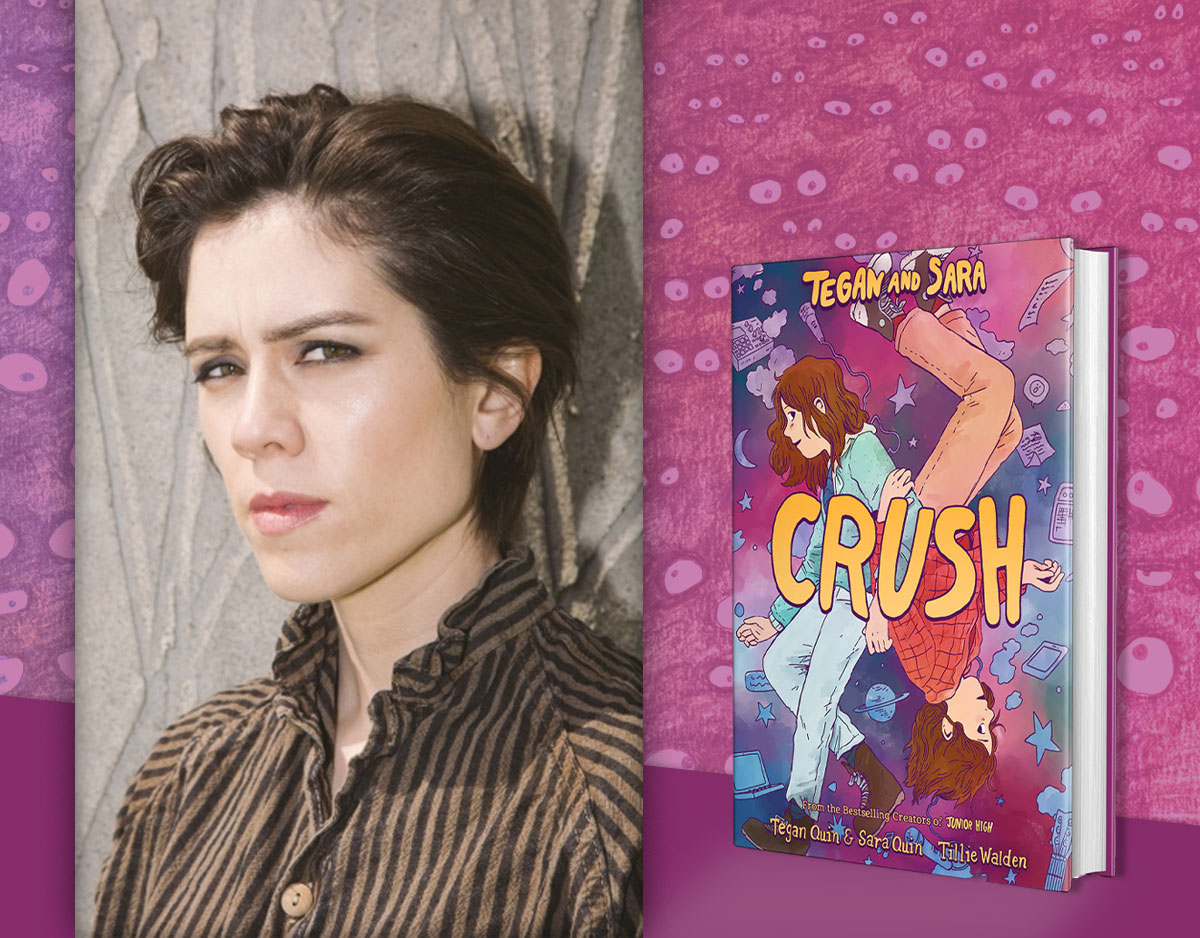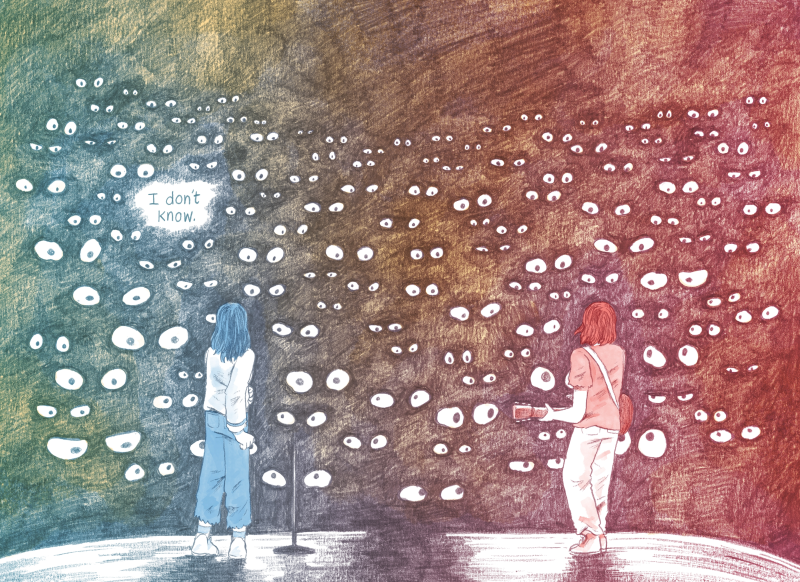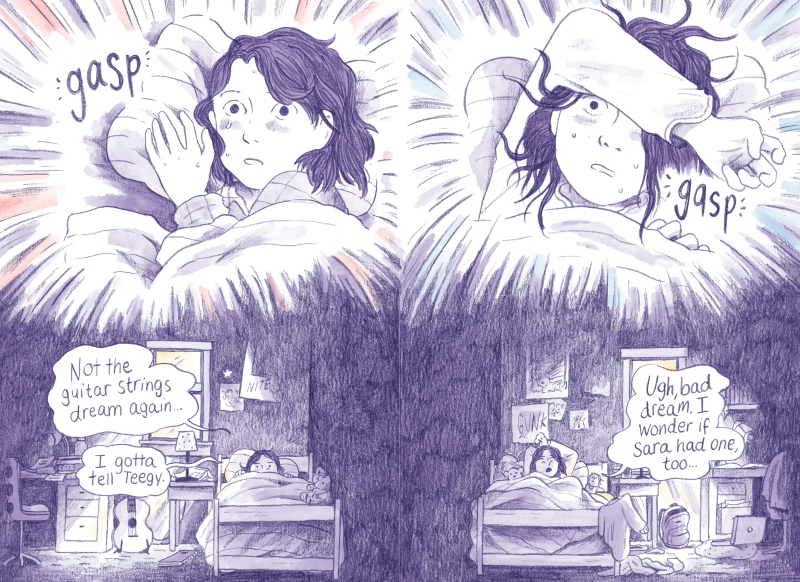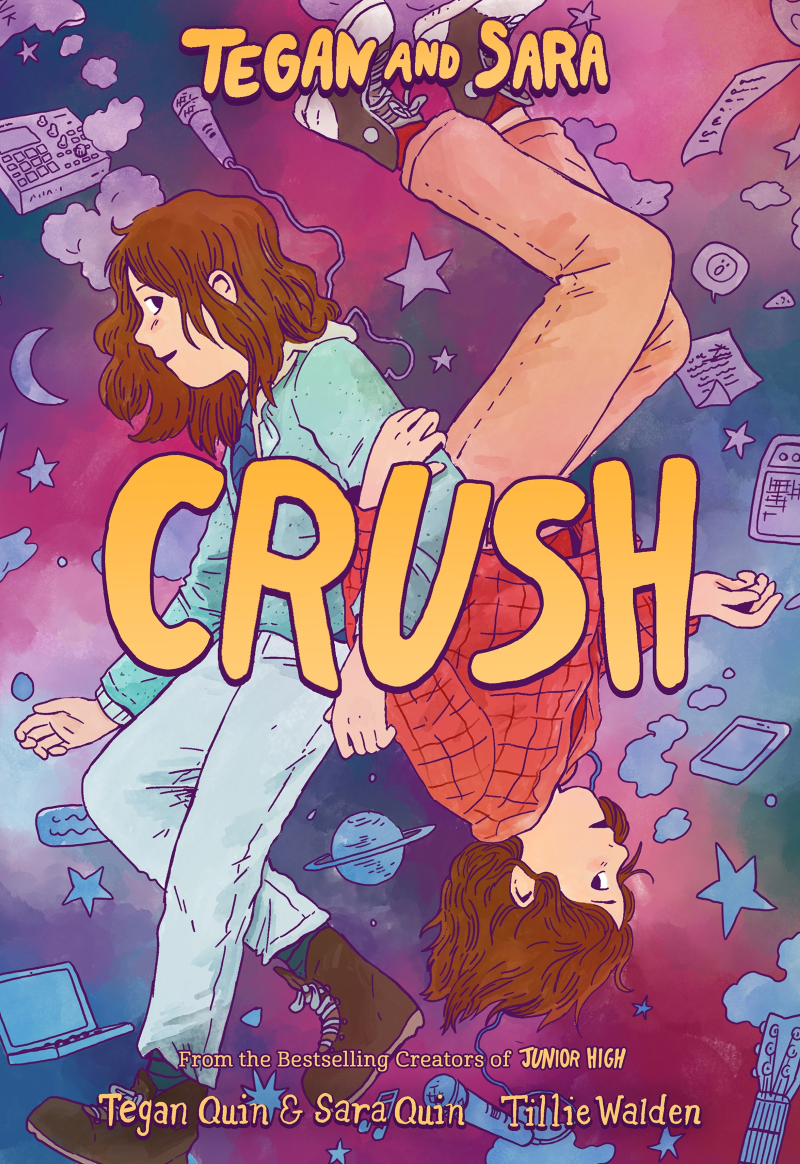Sara Quin of Tegan and Sara on Collaboration, Comics Books, and Coming of Age
Sara Quin of indie pop duo Tegan and Sara discusses the forthcoming final installment in the band’s graphic novel series, offering a glimpse into the life events and creative journey that resulted in Tegan and Sara: Crush.
 |
Photo of Sara Quin courtesy of Macmillan. |
Indie pop icons Tegan and Sara have teamed up once again with Eisner Award-winning artist Tillie Walden for the highly anticipated conclusion to their middle school memoir duology. Sara Quin spoke with Jasmine Amiri of School Library Journal about the forthcoming graphic novel, offering a glimpse into the life events and creative journey that resulted in Tegan and Sara: Crush.
Jasmine Amiri: This is a fabulous duology. Both 2023’s Tegan and Sara: Junior High and the upcoming conclusion, Crush, are outstanding middle grade graphic novels. What led to the decision to do them in the graphic novel format?
Sara Quin: You know, it wasn’t our idea. The publisher of our memoir, High School, put us in touch with their kids’ side of publishing and they said, “Look, we have an idea. We’d love to take your high school story, set it in junior high, turn it into a middle grade series, and do it as a graphic novel.” And we were like, “Great!” I give full credit to the publisher who dreamed up the idea, and thankfully, they were patient with us as we learned to work within the comic medium.
This was five or six years ago, and it’s funny to think about now. Translating it was so easy and fun, which is unusual because most of the projects we work on and develop come with more growing pains. With this, we had the shape of the story, and all we had to do was be creative and think about it like this was happening when we were in seventh grade. What would be the details that we could modulate that would make it feel more appropriate? Or what would happen if this story was happening now, and not in 1993?
It was a fun experiment to sit down and think about what details we would share with Tillie Walden, the artist. We had read a few graphic novel scripts that were provided by the publisher to see how it’s done, but even the examples varied, so Tegan and I went detail crazy. We would describe what the characters looked like, their facial expressions, what the room would look like—world-building in this way that would be impossible if it was written as a prose novel because it would be too much description. But it was so fun to hand Tillie this world, and she did such an incredible job. It was a really fun, collaborative way to work.
JA: How did you come to collaborate with Tillie Walden? Did you know that she’s a twin before working together?
SQ: We did not know that she was a twin! I have loved graphic novels since my teenage years, but I’ve always read adult graphic novels and hadn’t come across Tillie. The publishers recommended a list of artists to consider, and Tillie was the first one I looked at and I immediately read every single one of her books. It was a no-brainer. She’s just so funny and awesome.
The first time we all spent time together in person was when we were doing the book tour for Tegan and Sara: Junior High. She did a bunch of the events with us and I was like, “Can you just join our band?” She’s fantastic, such a nice balance to me and Tegan. She’s really wonderful.
JA: I think that actually rolls off the tongue —Tegan, Sara, and Tillie.
SQ: I think it’s great. I’m happy to give her top billing, as well. It can be Tillie, Tegan, and Sara.
 |
Interior pages from Tegan and Sara: Crush by Tegan Quin and Sara Quin ©2024. Artwork by Tillie Walden. |
JA: You touched on this earlier, but the book takes place in modern times while your actual middle school years were in the early 1990s. What led to the decision to set the book in the present day?
SQ: We had initially done a quick draft of a graphic novel script that was set in the actual time it happened. We thought that with the popularity of shows like Stranger Things, there is a nostalgia that is relatable to people who didn’t grow up in that time. But the publisher said they think it should be set now, to see these kids face unique challenges that maybe we wouldn’t have faced when we were kids, and that will make it more relatable. And to be completely honest, I think they were right.
In Crush, it was fun to play with this idea of social media and what it means to start your journey of figuring out your identity while simultaneously battling what other people think of you or what you think of yourself. I think that gave it a layered, new texture. If we had set it in the ‘90s, I would struggle to find a way to make it immediately digestible to a younger audience, because, for us, it happened later in life when we got out of high school and started getting reviews in newspapers. That thing that happens almost immediately now, the second you put your face online—it didn’t happen that way back when we were starting our band.
JA: Did you find yourself having to alter a lot of the story from your real experiences? Beyond the addition of things like cell phones and modern pop culture, how different are the events in the book from your days in middle school?
SQ: It’s weird—Tegan and I didn’t even talk that much about how to fictionalize it. We just knew we’re following the same trajectory of what happened to us. We were kids who were trying to figure things out, really into music, discovered we can make music—and almost immediately, people are drawn to us and to the music we’re making. It is based on our story, and the plot points and arc of what happened: figuring out who we are within our relationship as sisters, as individuals, to our friends, and maybe starting to figure out who we like romantically. We knew all of that and how it would land in the plot.
I would get the script back from Tegan and she would have pulled from things that happened in our real life, but they would be fresh somehow. Like in the first book, when we go bowling with our dad and his new girlfriend and one of us gets our period—that’s not how it actually happened. But we used to go bowling with my dad’s girlfriend and I can remember details that we could mine. We were always trying to keep it tethered to our story while also thinking about what it would be like to be 13 right now.
Then it was just about adding in, to your point, cell phones. But every time we would talk about technology, I would ask, is this really an addition ? Are we just adding a cell phone so people will know that *wink, wink* it’s set now? So, we really tried to make the technology a character in the book.
JA: Some of my favorite recurring moments were the conversations that happen in Tegan and Sara’s “twin magic” space. How did you come up with that concept?
SQ: Honestly, that was all Tillie. We had been talking a lot with our editors about whether we should add some kind of narration, like an older Tegan and Sara who jump into the story and help the reader get into the minds of the twins. And that could work, but I felt it would be interruptive to have adult versions of Tegan and Sara come in and tell the story or give more feedback about what’s happening. It was Tillie who came up with the genius way of having them share a mind space.
There’s also this beauty in it, it’s kind of ethereal. It’s not mind reading, we know they’re not having these conversations, but they know that they had these conversations. And I thought it was beautiful.
 |
Interior pages from Tegan and Sara: Crush by Tegan Quin and Sara Quin. Artwork by Tillie Walden. |
JA: You mentioned that you grew up reading graphic novels—what are some graphic novels that inspired you for this, or that you used as touchstones for Junior High and Crush?
SQ: Growing up, I loved Calvin and Hobbes. That was one of my first introductions to comics. My stepdad loved Batman and Spider-Man comics. He was the one who asked, “Have you ever read comics?” And we were big readers, but weren’t really into those, so he gave us Calvin and Hobbes and we would cry from laughing. We thought it was so amazing.
I wouldn’t say that when we sat down to work on this book, we thought “Calvin and Hobbes,” but I always loved the humor and the magical element of hanging out with a stuffed animal. It doesn’t feel like it’s just for kids—even my stepdad would read those books. That kind of comic and storytelling in the middle grade space, when it can be entertaining for older people but really relatable for a younger audience. I think that was the balance we were trying to figure out.
Tegan and I read stacks of middle grade graphic novels before we did this. There are so may wonderful ones, but I think what you are, as a writer or storyteller, is not necessarily something you can learn from reading a bunch of books. I think it’s who you are, so the Calvin and Hobbes series feels more like the original seeds. Just like with music, people will ask, “What influences you, what’s inspiring to you?” I mean, it’s the things I listened to when I was in the 1980s: it’s still Cyndi Lauper, Madonna, Bruce Springsteen, and Prince. It doesn’t matter how much new stuff I absorb, it’s like the foundational part of me is Calvin and Hobbes and Cyndi Lauper.
JA: That’s a great combo, though. I just have one final question: What is one thing that you want readers to take away from the duology, and from Crush, specifically?
SQ: We really struggled with social dynamics in middle school; it is such a hard age. Grades 7 and 8 can be brutal, and we kept it a little lighter for these books, but it should feel like a companion. Like no matter what is going on in your real life, you can find a safe space and comfort in the story and in these characters.
With this book, more than anything else we’ve done, I hope it’s aspirational. These are the kinds of friendships and connections that you can have. And maybe it’s not music, but if you find something that allows you to connect to another person, or to yourself, or to a feeling that you’re having, that is so achievable. I hope those things resonate with anyone reading.
 |
Cover artwork for Tegan and Sara: Crush. Artwork by Tillie Walden. |
|
Tegan and Sara: Crush will be available in libraries and bookshelves everywhere on 10/1/2024. Publisher: Farrar, Straus and Giroux (BYR) | Publication Date: 10/1/2024ISBN: 9780374313036 |
 Jasmine Amiri is the graphic novel reviews editor at SLJ.
Jasmine Amiri is the graphic novel reviews editor at SLJ.
RELATED
The job outlook in 2030: Librarians will be in demand
The job outlook in 2030: Librarians will be in demand
ALREADY A SUBSCRIBER? LOG IN
We are currently offering this content for free. Sign up now to activate your personal profile, where you can save articles for future viewing






Add Comment :-
Be the first reader to comment.
Comment Policy:
Comment should not be empty !!!